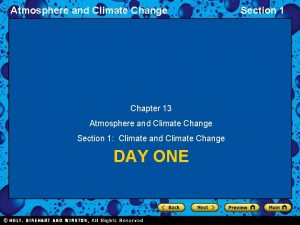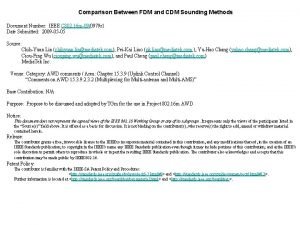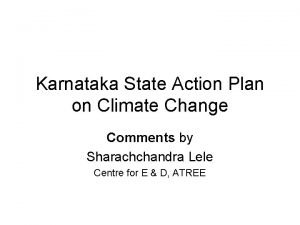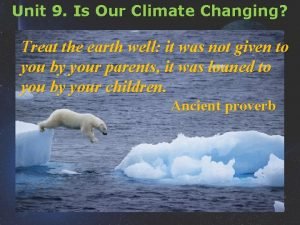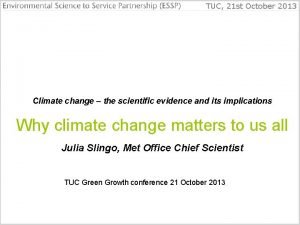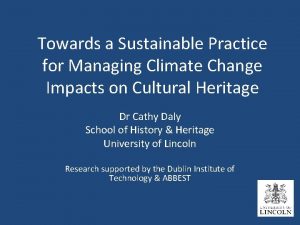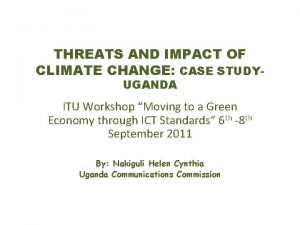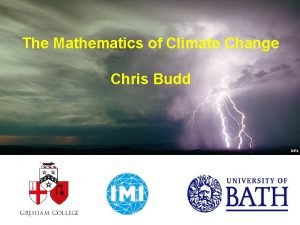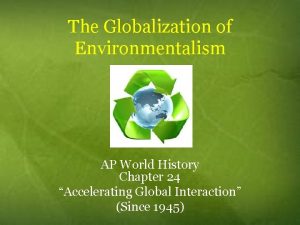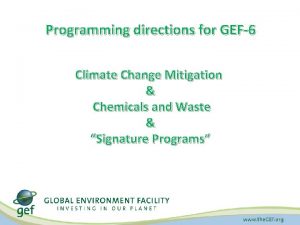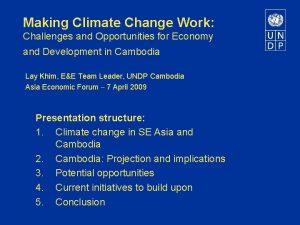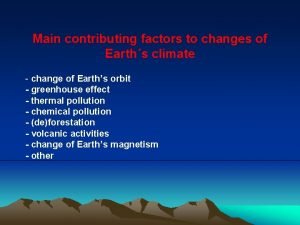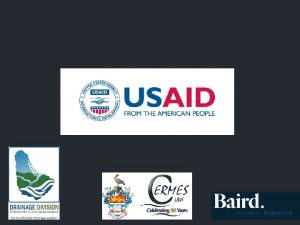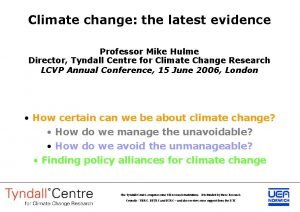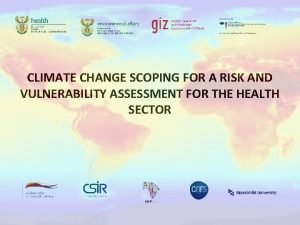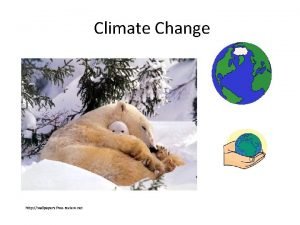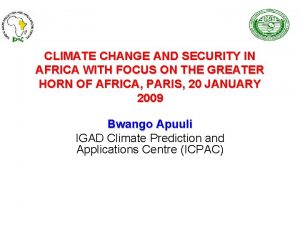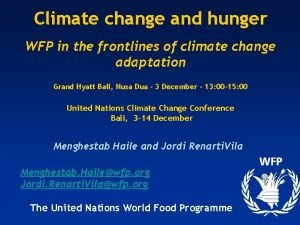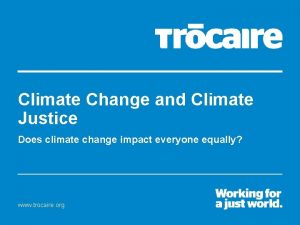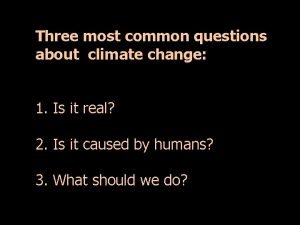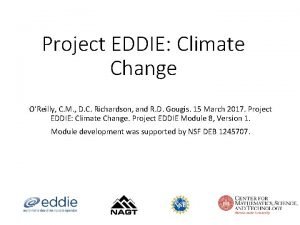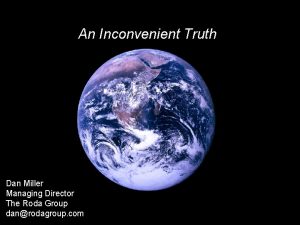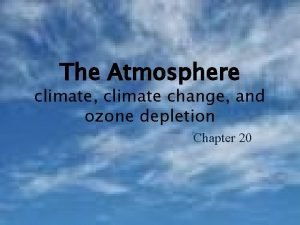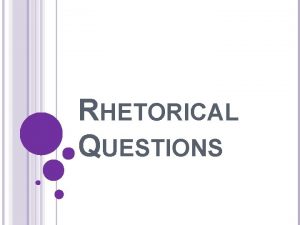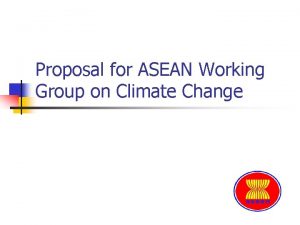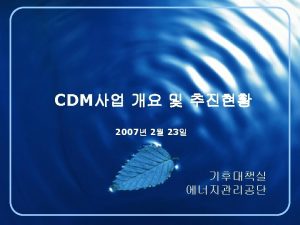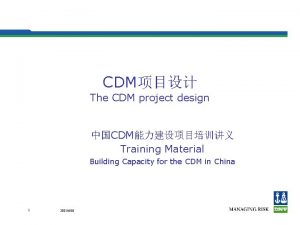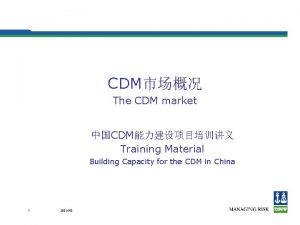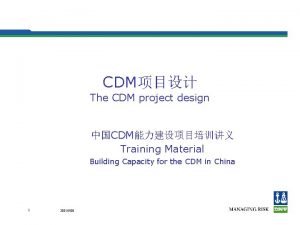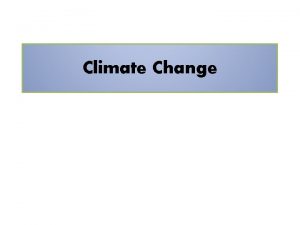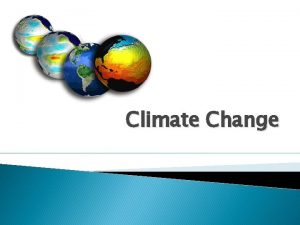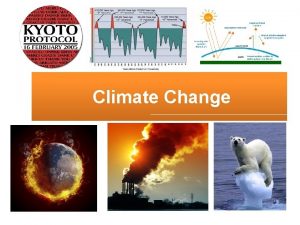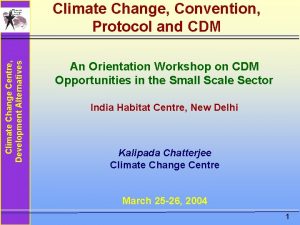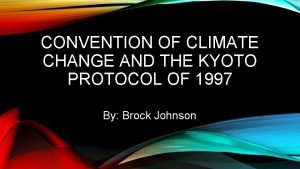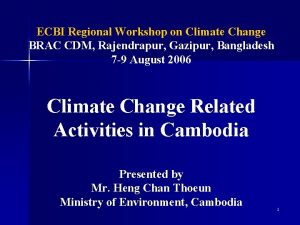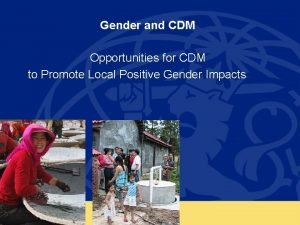Climate Change Convention Protocol and CDM Workshop on

































- Slides: 33

Climate Change Convention, Protocol and CDM Workshop on Clean Development Mechanism: Opportunities in Rajasthan Hotel Clarks Amer, Jaipur Kalipada Chatterjee Climate Change Centre Development Alternatives January 28 -29, 2005

Global Warming Science of Climate Change In the last 2 decades, two important events have far-reaching consequences for life on our planet. These are : v Appearance of ozone hole v Compelling scientific evidence of global warming ………due to human activities climate has changed over the millennium, but the concern is the rate of change of climate 2 Development Alternatives

Atmospheric Concentration of Green House Gases v v v 3 ppmv = parts per million by volume; ppbv = parts per billion (thousand million) by volume; pptv = parts per trillion (million) by volume; Development Alternatives

Changes in the Atmosphere : Composition, Circulation Changes in the Hydrological Cycle Changes in Solar Inputs Cloud s Atmosphere N 2, O 2, Ar, H 2 O, CO 2, CH 4, N 2 O, O 3, etc. Aerosols Atmosphere-Ice Interaction Precipitation Evaporation Heat Wind Exchange Stress Atmosphere-Biosphere Interaction Terrestrial Radiation Human Influence Ice Sheet Sea Ice Hydrosphere: Ocean Ice-Ocean Coupling Changes in the Ocean: Circulation, Sea Level, Biogeochemistry Biosphere Soil-Biosphere Interaction Hydrosphere: Rivers & Lakes Cryosphere: Sea Ice, Ice Sheets, Glaciers Changes in/on the Land Surface: Orograogy, Land Use, Vegetation, Ecosystems Land. Atmosphere Interaction Land Surface

What is the Role of the Atmosphere ? v The mean annual concentration of CO 2 is relatively homogenous through out the troposphere (the troposphere is mixed on a time scale of about 1 year) v Role of Oceans Ø Ø Largest reservoirs of carbon Global warming may result in release of carbon into the atmosphere v Role of earth’s vegetation and soils Ø 5 exchange of carbon through photosynthesis, plant respiration, and microbial conversion of the organic material in the soil back into CO 2 Development Alternatives

Why the GHGs are increasing The GHGs in the atmosphere are increasing mainly due to human activities which include: v Energy production from fossil fuels v Industries v Transport v Construction v Agriculture v Land use change and deforestation v Rapid population growth 6 Development Alternatives

Global Action v 1988: Formation of IPCC Ø Ø Ø First Assessment Report: 1990 Second Assessment Report: 1995 Third Assessment Report: 1995 v 1992 : ………conclude that the balance of evidence suggests a discernible human influence on global climate Change Convention During the June’ 92 Earth Summit at Rio de Janerio representatives of 154 countries signed the UN Framework Convention on Climate change. 7 Development Alternatives

Global Action v 1997: Adoption of Kyoto Protocol Ø Will enter into force after it has been ratified by at least 55 Parties to the Convention accounting for at least 55% of the total 1990 CO 2 § Ø 8 February 16, 2005 Under Article 3 of the Protocol the Annex 1 countries agreed to quantified emissions limitation and reduction commitments (QELRCs) by at least 5. 2% below their 1990 levels. Development Alternatives

Global mean surface temperatures have increased 9 Development Alternatives

Indian Scenario Aggregate emissions in 1994; 1228 (million tonnes)? CO 2 eq. Relative emissions of GHGs from India in 1994 55 N 2 O 380 CH 4 793 CO 2 0 200 400 600 Gigagram 10 Development Alternatives 800 1000

11 Development Alternatives

Indian Scenario v As a member of the UNFCCC since its inception, India’s NATCOM brought out the following depicting India’s vulnerability to CC: Ø Increase in water stress and reduction in the availability of fresh water. Ø Threats to agriculture and food security, since rain-fed agriculture is highly monsoon dependent. Ø Shifts in area and boundary of different forest types and threats to bio-diversity with adverse implications forest dependent communities. Adverse impacts on • natural ecosystems. • impacts of sea level rise on coastal agriculture, fisheries and Ø settlements. human health. Ø 12 • Increased energy requirement and impact on climate sensitive industries and infrastructure. Development Alternatives

Climate Change & India’s Concern v 13 v The third assessment report of IPCC (IPCC 2000) projects that under the combined influence of GHGs and sulphate aerosols climate may warms globally by 1. 4 to 5. 80 C by the next 100 years Over the Indian region, the warming will be restricted to : Ø 1. 4 + 0. 130 C in 2020 Ø 2. 5 + 0. 40 C in 2050 Ø 3. 8 + 0. 50 C in 2080 v Rainfall is projected to increase by 2% (2020) to 7% (2080) v Sea level is projected to rise between 0. 09 to 0. 88 m in the period 1990 to 2100 v Extreme events such as excessive rain, flash floods, droughts, cyclones and forest fire are likely to increase. v The combined effect of climate change and increase in extreme events is expected to lead to significant impacts on water resources, agriculture, on food security, human health, habitat and fragile ecosystems like mangroves etc. Development Alternatives

Climate Impacts on Rajasthan v The state of Rajasthan experiences an arid and semi-arid climate and is situated in the north western part of India. v India’s initial national communication, submitted to the UNFCCC projected that under climate change scenario 60% area of Rajasthan is likely to experience acute physical water scarce conditions. v 1987 -88 and 2002 -2003 were the severest ones so far. 14 Development Alternatives

Addressing Climate Change v The possible options are : 15 Ø Mitigation of climate change through domestic actions by developed countries signatories to KP and through mechanisms like CDM Ø Adaptation to climate change, by vulnerable communities for increasing their coping capacity and resilience Development Alternatives

Clean Development Mechanism (CDM) v The purpose of CDM is to : 16 Ø assist developing countries in achieving sustainable development Ø contribute to the ultimate objective of the Convention i. e. stabilisation of greenhouse gas concentration in the atmosphere at a level that would prevent dangerous anthropogenic interference with the climate system, and Ø assist developed countries in achieving compliance with their Quantified Emission Limitation and Reduction commitments (QELRCs) Development Alternatives

How does CDM work v To be taken from IGES document 17 Development Alternatives

CFCs 11 and 12 CARBON DIOXIDE OTHER CFCs NITROUS OXIDE METHANE The contribution from each of the human-made greenhouse gases to the change in radiative forcing from 1980 to 1990. The contribution from ozone may also be significant, but cannot be quantified at present 18 Development Alternatives

Climate Change Convention During the June’ 92 Earth Summit at Rio de Janerio representatives of 154 countries signed the UN Framework Convention on Climate change. Objectives of the UNFCCC v To achieve stabilisation of GHG concentrations in the atmosphere at a level that would prevent dangerous anthropogenic interference with the climate system v Such a level should be achieved within a time-frame to : Ø 1. 19 to ensure food production is not threatened, and to enable economic development to proceed in a sustainable manner Development Alternatives

Climate Change Convention During the June’ 92 Earth Summit at Rio de Janerio representatives of 154 countries signed the UN Framework Convention on Climate change v The UNFCCC came into force on March 21, 1994. As on Co. P 9 (at Milan, Italy December, 2003) there at present 188 Parties to the Convention. 20 Development Alternatives

Addressing Global Warming and Climate Change The possible options are : Ø Mitigation of climate change Ø Adaptation to climate change 21 Development Alternatives

C C FC UN eloping Dev s’ e i r t n Cou e v i t c e Persp The Climate Change Convention is not merely for the stabilisation of the concentration of GHGs in the atmosphere; Ø Ø 22 poverty eradication and economic and social development in the developing countries, are also central, though implicit in the Convention Development Alternatives

BENEFITS THAT INDIA EXPECTS FROM CDM PROJECT ACTIVITIES ARE : 23 q Capacity building in project development and implementation q Social development, economic development, environment protection and technological development and transfer, leading to the realisation of sustainable development and to address to India’s main agenda : poverty eradication and better quality of life to people q Additional foreign investments q A share of CERs q A cleaner path for rapid economic development Development Alternatives

PARTICIPATION REQUIREMENTS OF A DEVELOPING COUNTRY PARTY According to Marrakesh Accords, participation requirements of a developing country Party (e. g. India) in the CDM Process are : q Voluntary q A Party not included in Annex I may participate in a CDM project activity if it is a Party to the Kyoto Protocol, and q Have set up a Designated National Authority (DNA) 24 Development Alternatives

Enabling Environment for CDM in India q India’s ratification of the Kyoto Protocol q Designated National Authority (DNA) in place q Go. I’s endorsement of a number of CDM Projects so far Enabling environment was further strengthened by hosting the COP 8 at New Delhi, Prime Minister of India’s address at COP 8 and Delhi Declaration 25 Development Alternatives

ADDRESSING GHG MITIGATION IN INDIA q Focus of the abatement strategy is CO 2 emissions reductions in the energy sector and forestry sectors and CH 4 emissions reduction in the agriculture sector q Mitigation Options in the energy sector identified are : improvements in energy efficiency through upgrading currently employed technologies and Ø introduction of advanced technologies that are more efficient Ø use of renewable energy sources wherever feasible to bring down the carbon content of the grid, to provide sustainable energy, and as a decentralised energy source at remote areas Ø 26 Development Alternatives

Focus of the Present Orientation Workshop and Expectations Focus : q Initiate a process and bring different stakeholders from state and country level to a common platform for raising awareness and build capacity on the clean development mechanism, particularly in the small scale sector such as brick, rice mill, hotel and small scale renewable energy project activities as defined under the Marrakech Accords (Co. P 7) and recent CDM executive board modalities and procedures on small scale CDM. 27 Development Alternatives

Focus of the Present Orientation Workshop and Expectations Expectation : 28 q This orientation workshop under IGES and CCC, DA initiatives will lead to a three year CDM capacity building programme amongst the different stakeholders in India. q Assist Project Developers to initiate CDM project activity in their respective sectors. q Facilitate to develop, design and implement a number of CDM projects under the small scale sector and strengthen learning processes by doing q Assist in achieving sustainable development objectives q Assist in the mitigation and adaptation to climate change, poverty eradication and rural development in the longer term to address to poverty eradication and providing better quality of life to all. Development Alternatives

NGO INITIATIVES : CLIMATE CHANGE CENTRE, DEVELOPMENT ALTERNATIVES q Among the NGOs, Development Alternatives has set up a Climate Change Centre q Activities of the Climate Change categorised under three broad heads : Centre are A. Research 29 Ø Development of methodologies Ø Analysis and determination of baselines Ø Analysis and documentation of experience and lessons learned worldwide for capacity building Ø Quantified indicators of sustainability for CDM (Contd. . . ) projects Development Alternatives

NGO INITIATIVES : CLIMATE CHANGE CENTRE, DEVELOPMENT ALTERNATIVES (Contd…) B. Facilitations Ø Project formulation Ø Approval process Ø Identification of partners and technologies Ø Providing linkages to reduce transaction costs Ø Assisting in negotiations C. Outreach and Awareness 30 Ø Organising regional workshops on CDM project development Ø Participation in Co. Ps, Ø Closely interacting with Govt. and Industry on issues on climate change, CDM etc. particularly on policy analysis and operational issues Ø Bringing out publications, research papers / articles Development Alternatives

Initiatives taken by the Various Stakeholders in India can be further Reinforced by proactive role of financial institutions: q Finance being one of the main hurdles in the promotion of Renewable Energy, a proactive role with well defined programmes of the Financial Institutions may considerably help in accelerating promotion of RETs in the rural development through CDM q By internationally agreeing to a minimum price of per tonne of CO 2 reduced particularly through small scale CDM activities q Minimising transaction costs / upfront costs 31 Development Alternatives

CONCLUSION Clean Development Mechanism : q catalyses sustainable development in longer term q promote international co-operation in mitigation of climate change in short as well as longer term q increase resilience and coping capacity of communities through increased sustainable livelihoods and other tools for adaptation to climate change q narrow the gap between the haves and have nots in longer term q may lead to equitable distribution of resources in longer term q will address to rural development and poverty eradication in India in the longer term To speed up the process of CDM in India and to encourage different stakeholders, Go. I may introduce a concept of “CARBON RESERVE” by banking carbon reduced or sequestered in line with India’s gold reserve and foreign exchange reserve as a part of India’s climate change policy in the longer term. 32 Development Alternatives

33 Development Alternatives
 Climate change 2014 mitigation of climate change
Climate change 2014 mitigation of climate change Climate change meaning
Climate change meaning Chapter 13 atmosphere and climate change section 1
Chapter 13 atmosphere and climate change section 1 Chapter 13 atmosphere and climate change
Chapter 13 atmosphere and climate change Fdm
Fdm Climate change paragraph
Climate change paragraph Karnataka state action plan on climate change
Karnataka state action plan on climate change Brainpop climate types
Brainpop climate types Unit 9 climate change
Unit 9 climate change Conclusion of climate change
Conclusion of climate change Youreuropemap.com
Youreuropemap.com Conclusion of climate change
Conclusion of climate change Mathematics of climate change
Mathematics of climate change Globalization definition ap world history
Globalization definition ap world history Climate change mitigation
Climate change mitigation 414 climate change
414 climate change Conclusion of climate change
Conclusion of climate change Factors of climate change
Factors of climate change Human causes of climate change
Human causes of climate change Conceptual framework
Conceptual framework Uk climate change
Uk climate change Climate change interview
Climate change interview Factors effecting climate change
Factors effecting climate change Conclusion of climate change
Conclusion of climate change Conclusion of climate change
Conclusion of climate change Climate change causing droughts
Climate change causing droughts Climate change hypothesis
Climate change hypothesis Project eddie climate change
Project eddie climate change Financing education in a climate of change
Financing education in a climate of change Climate change pathos
Climate change pathos Dan miller climate change
Dan miller climate change Un climate change
Un climate change What does rhetorical mean
What does rhetorical mean Asean working group on climate change
Asean working group on climate change



